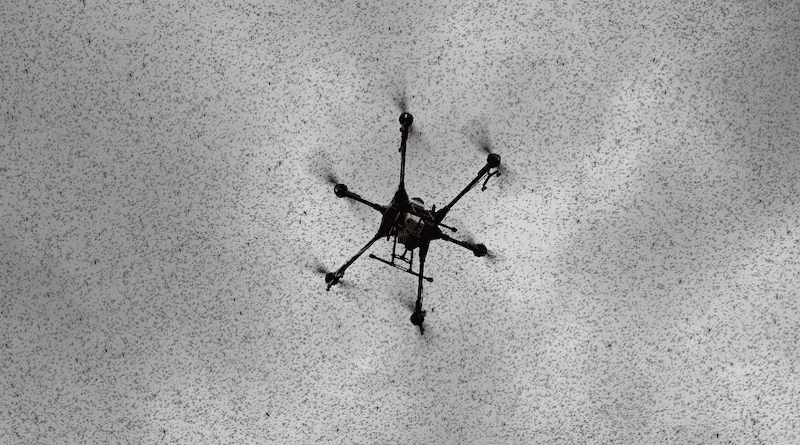Study Determines Optimum Height For Drones To Fly And Target Desert Locusts With Biopesticide
A study, led by the first winner of the inaugural Carol Ellison Science Award 2021, has determined the optimum height for a drone to fly and target desert locusts with biopesticides in order for it be most effective as a tool to fight the devastating crop pest.
Violet Ochieng, of the University of Nairobi and who was supervised for her PhD by Dr Ivan Rwomushana – CABI’s Senior Scientist, Invasive Species Management based at CABI’s regional centre for Africa in Nairobi, found that a height of 10 metres is best for the drone to spray biopesticide on the desert locust below.
Ms Ochieng, who is the first winner of the Carol Ellison Science Award – which is awarded to a student doing her/his research with CABI – with the objective of enriching their research experience with the organisation, conducted her research which was published in the journal Drones and part funded by the award.
The research, which was also conducted in partnership with fellow scientists from the University of Nairobi, CABI and Astral Aerial Solutions.
The desert locust is one of the most destructive migratory pests in the world. In 2019-2020, according to the Food and Agriculture Organization (FAO), around 20 million people in Ethiopia, Kenya, Somalia, South Sudan, Tanzania and Uganda faced acute food insecurity due to swarms of desert locust.
In Kenya, the outbreak represented the worst locust crisis in 70 years; by its peak, the country was tackling over 500 swarms in 28 of Kenya’s 47 counties.
The new study highlights that while current methods of control rely on conventional chemical insecticides during invasion, some environmentally friendly biopesticides based on Metarhizium acridum and insect growth regulators can also be deployed in preventative control operations.
Ms Ochieng said, “The successful use of drones to control pests such as fall armyworm, planthoppers, aphids, among others, makes it an attractive technology that has the potential to also improve locust management, especially in inaccessible areas. However, key parameters for the safe and optimal use of drones in desert locust control were not documented before I began this study.
“Management of desert locusts by the use of drone technology appears promising when the biopesticides are applied at an optimum height of 10 metres and standard operating procedures are followed. Further research could also explore the gap in the effects of environmental parameters on flight application efficiency.”
To test the optimum height for spraying Metarhizium acridum on the locusts, the drone was flown at five different heights: 2.5 metres, 5 metres, 7.5 metres, 10 metres, and 12.5 metres.
At each height, the drone sprayed the ink mixture on spray cards pinned to the ground to approximate the droplet density and compare it to the standard droplet density recommended for desert locust control.
To assess the efficacy of M. acridum and the effectiveness of drones in its application, 50 grams of spores were mixed in 1 litre of diesel and sprayed on caged live locusts of different stages (3rd and 4th instars, as well as the adults); they were monitored for twenty-one days in a controlled room, and their mortality was determined.
Variation in droplet density between the tested heights was significant, the scientists say. A height of 10 metres agrees with the recommended standard droplet density within the 45 droplets/cm2 range.
Mortality varied among the locusts’ developmental stages within and between heights. Survival probability varied between heights for 3rd instar, 4th instar, and adults. All the developmental stages of the desert locust were susceptible to Novacrid and the recommended target stage is the 3rd instar.
Dr Rwomushana, a co-author on the paper, said, “This study has demonstrated that spraying desert locusts using a drone at any height below 10 metres may lead to over-deposition of the biopesticide, while heights above 10 metres may lead to under-application, which may limit exposure of the locusts to Metarhizium spores or pesticide molecules.
“This study demonstrated that spraying a control agent from a specific height is more effective than other heights tested.”
The scientists conclude that targeting the most susceptible early stages is also cost-effective in terms of the density of bands that will be controlled at once unlike the female adult desert locusts which can lay at least one egg pod before dying after an estimated 21 days of Novacrid application.

